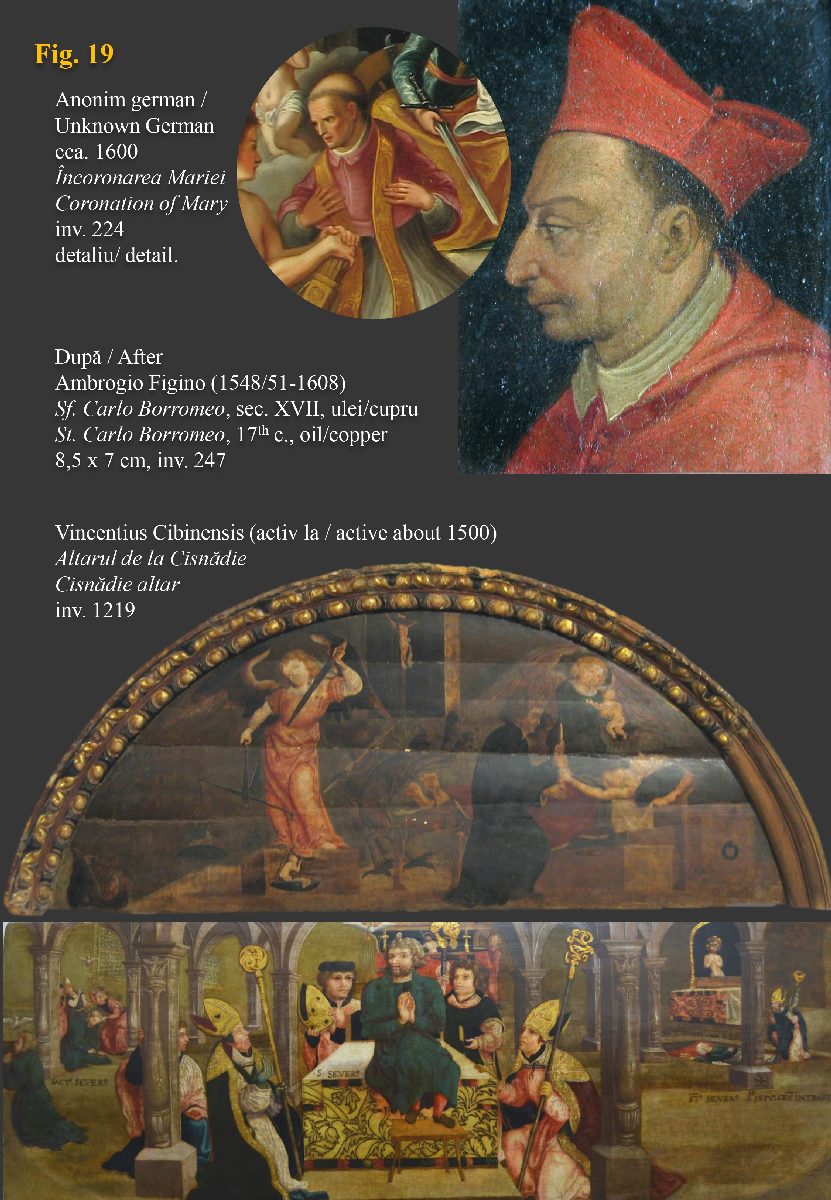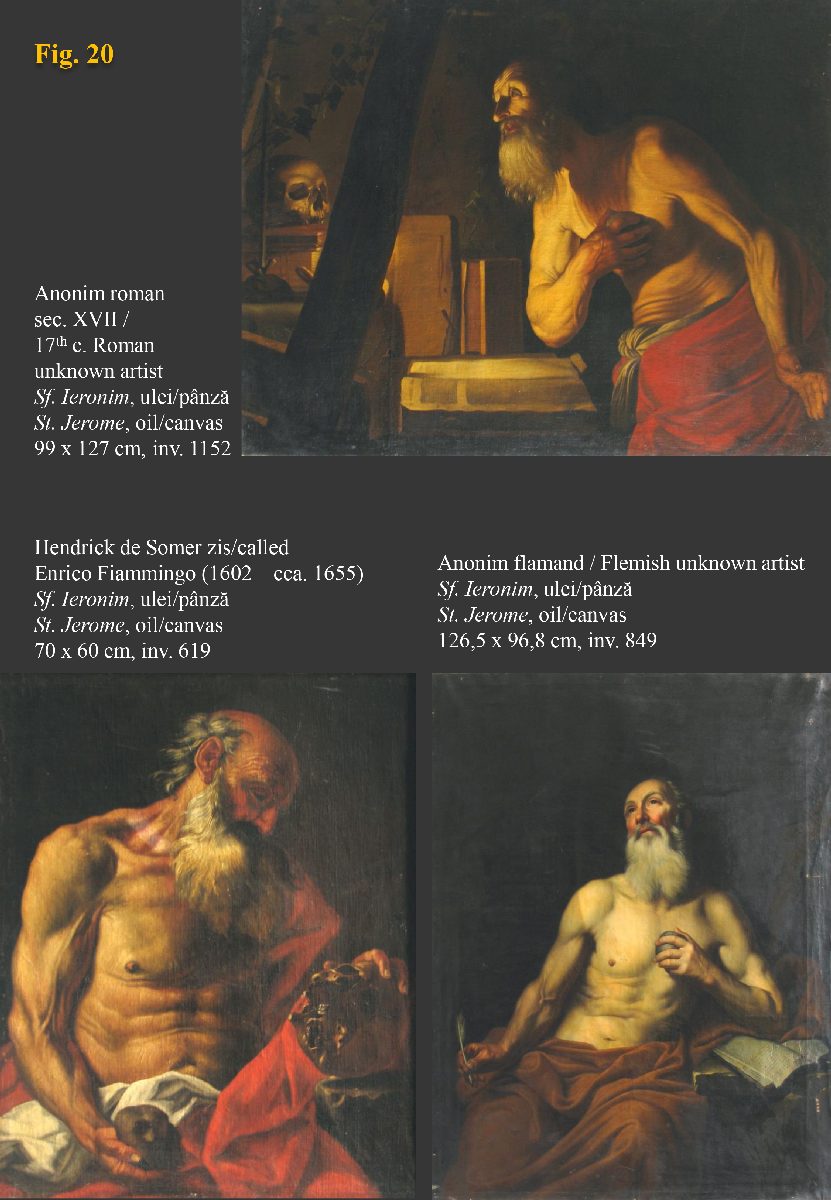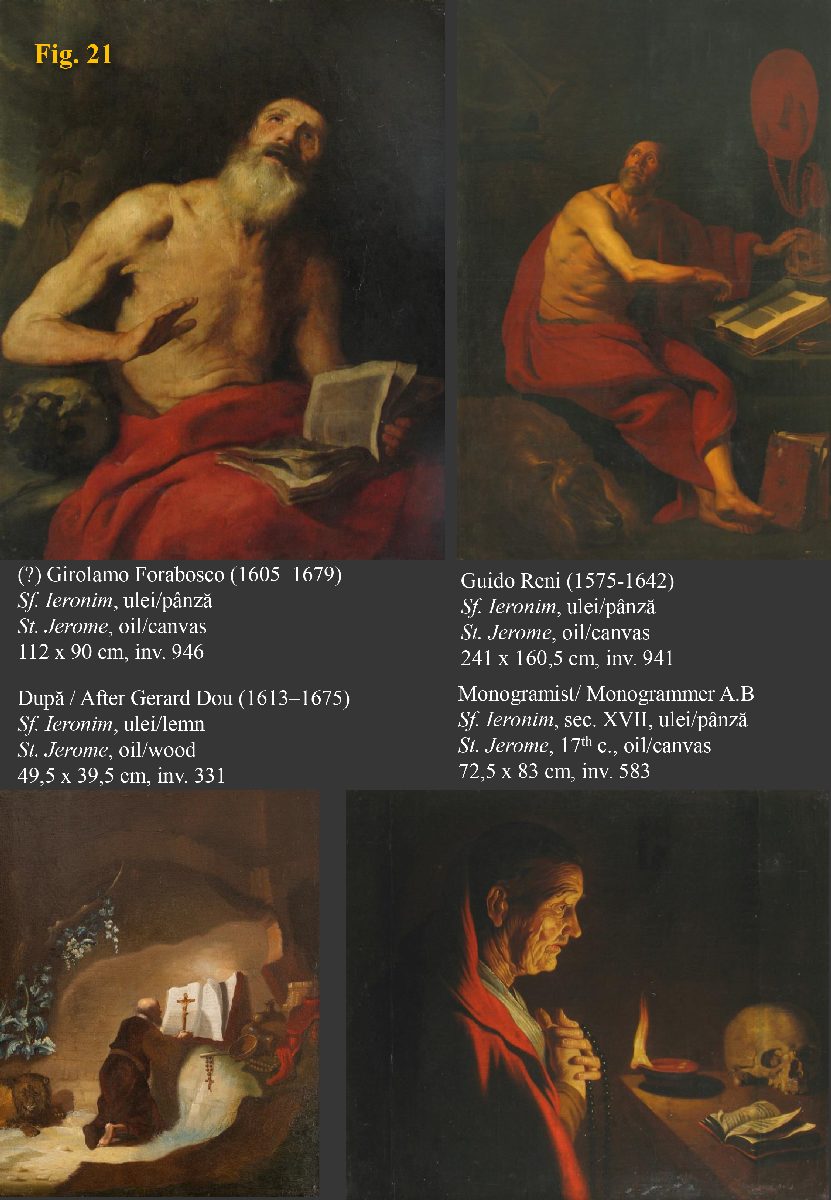Part 7: Hierarchs and Doctors of the Church
The hierarchs of the Catholic Church, headed by the Pope as the successor of St. Peter, have the role of guiding and supervising the clergy (especially the lay one), while also continuing to be the spiritual guides of the faithful in their dioceses.
As we have already seen, in the composition The Coronation of Mary (inv. 224) Pope Gregory the Great, Patriarch Athanasius of Alexandria, Bishop Augustine of Hippo Regius and Cardinal Carlo Borromeo are depicted.
A portrait of St. Carlo Borromeo (1538–1584), archbishop of Milan, promoter of the Counter-Reformation in northern Italy and Switzerland, is in the museum's collections (Fig. 19), painted by an anonymous German from the 17th c., after Ambrogio Figino (1548–1608); the original, dated ca. 1585, is in the Museo Diocesano di Milano – Veneranda Biblioteca Ambrosiana. The saint is shown without a halo because he was canonized later, on November 1, 1610.
The Cisnădie altar (inv. no. 1219), painted by Vincentius Cibinensis (active in 1500), is dedicated to St. Severus of Ravenna († ca. 348), the preserved fragments showing different scenes from the tradition related to him (Fig. 19). A simple weaver, married, he was elected bishop as a result of a dove landing three times on his head (interpreted as a divine sign), while assisting in the election of a successor to bishop Agapitus. He attended the Council of Sardica (343) and was buried next to his wife Vincentia, who became a nun.
Doctors (or scholars) of the Church represent a special, highly prestigious category, theologians who made fundamental doctrinal contributions.
Currently, the Catholic Church recognizes 37 doctors (33 men and 4 women) from Europe (27), Asia (7) and Africa (3). Among them are 2 popes and 19 bishops, as well as priests, deacons, monks and nuns. 18 of the doctors of the Church, who died before the Great Schism of 1054, are also honored by the Greek Orthodox Church. Before the 16th century, the Catholic Church recognized 4 doctors from the West (St. Gregory the Great, St. Ambrose, St. Augustine of Hippo Regius and St. Jerome) and 4 doctors from the East (that is the Three Holy Hierarchs, respectively St. John Chrysostom, St. Basil the Great and St. Gregory of Nazianzus, to whom was added St. Athanasius, Patriarch of Alexandria).
In the Coronation of Mary (inv. 224) St. Gregory the Great, St. Jerome, St. Augustine and St. Athanasius are represented.
The Brukenthal National Museum’ collection includes numerous representations of St. Jerome, the translator of the Bible into the Latin language (Vulgata), a fact that suggests the special importance attributed by Protestants to the translation of the scriptures. In addition to the well-known works painted by Lorenzo Lotto (inv. 697) and Marinus van Reymerswaele (inv. 983), in which St. Jerome is rendered as a penitent, respectively a scholar working in the scriptorium, we encounter the category of the penitent who interrupts his study of the scriptures, respectively the work on their translation (Fig. 20). We find this approach in a work attributed to an anonymous Roman artist from the 17th century (inv. 1152), probably influenced by a work by Hendrick de Somer called Enrico Fiammingo (1602 – ca. 1655), dated 1652, kept at the Galleria Nazionale di Palazzo Barberini in Rome and also in the work of an anonymous Dutchman (inv. 849). According to A. Sonoc, these works clearly suggest that the atonement of sins through penance, as an expression of the hermit's humility, is above the desire for knowledge, for fame accumulated by writing books, which the scholar craves. A work dated in the second half of the 1640s, most likely wrongly attributed to Girolamo Forabosco (1605–1679), and a product of the workshop of Guido Reni (1575–1642) belong to the category of representations in which the painter insists on the learned state of St. Jerome (Fig. 21), working under divine inspiration.
Finally, we mention two works displaying the theme of St. Jerome praying (Fig. 21). Attributed to an imitator of Gerard Dou (1613–1675), one of the paintings represents him as a hermit in a grotto, kneeling with his back to the viewer, praying before a crucifix and an opened Bible. As a result of the old re-paintings, the character could be surely identified only after the restoration in 2023. The second work, attributed since 1901 to the genre of Gerard van Honthorst (1590–1656), represents St. Jerome in the specific vestments of a cardinal. On the pages of the book, A. Sonoc distinguished a false writing and as initials at the beginning of the paragraph, written in red, the letters A and B, the artist's monogram, the work being dated to the middle of the 17th century.
Click an image below to open it




